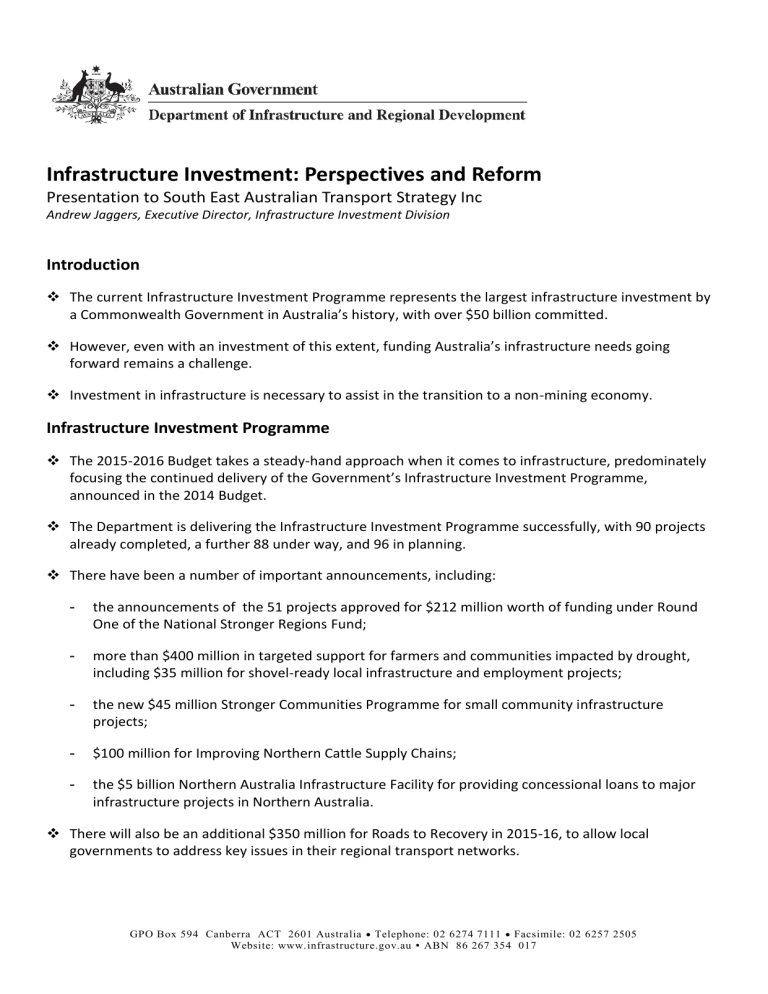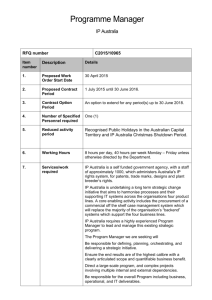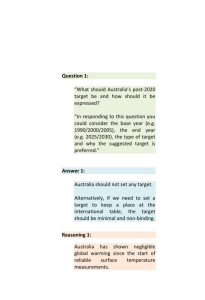SEATS May Summary

Infrastructure Investment: Perspectives and Reform
Presentation to South East Australian Transport Strategy Inc
Andrew Jaggers, Executive Director, Infrastructure Investment Division
Introduction
The current Infrastructure Investment Programme represents the largest infrastructure investment by a Commonwealth Government in Australia’s history, with over $50 billion committed.
However, even with an investment of this extent, funding Australia’s infrastructure needs going forward remains a challenge.
Investment in infrastructure is necessary to assist in the transition to a non-mining economy.
Infrastructure Investment Programme
The 2015-2016 Budget takes a steady-hand approach when it comes to infrastructure, predominately focusing the continued delivery of the Government’s Infrastructure Investment Programme, announced in the 2014 Budget.
The Department is delivering the Infrastructure Investment Programme successfully, with 90 projects already completed, a further 88 under way, and 96 in planning.
There have been a number of important announcements, including:
the announcements of the 51 projects approved for $212 million worth of funding under Round
One of the National Stronger Regions Fund;
more than $400 million in targeted support for farmers and communities impacted by drought, including $35 million for shovel-ready local infrastructure and employment projects;
the new $45 million Stronger Communities Programme for small community infrastructure projects;
$100 million for Improving Northern Cattle Supply Chains;
the $5 billion Northern Australia Infrastructure Facility for providing concessional loans to major infrastructure projects in Northern Australia.
There will also be an additional $350 million for Roads to Recovery in 2015-16, to allow local governments to address key issues in their regional transport networks.
GPO Box 594 Canberra ACT 2601 Australia
Telephone: 02 6274 7111
Facsimile: 02 6257 2505
Website: www.infrastructure.gov.au ABN 86 267 354 017
South Eastern Australia
There are a number of important projects underway across the South Eastern Australia region.
In November 2014, the Australian Government committed a further $70 million towards the duplication of the Princes Highway East between Traralgon and Sale, which has been identified by
SEATS as priority transport corridor.
In the ACT, we are working with the Territory government to deliver the Majura Parkway upgrade.
Once completed, this project will provide an improved freight link for vehicles travelling between
Sydney, western NSW, the Monaro region and the Act.
There are also a number of a smaller, high benefit projects across the region, such as the Sand Road grade separation at Longwarry, which will significantly improve safety and speed for highway users.
I would expect to see more commitments from the Government towards infrastructure projects across
Australia over the next 12 months, leading up to the 2016-17 Budget.
Targeted investment in an era of fiscal constraint
It is important to recognise that all governments in Australia are facing tight fiscal constraints.
That is why the Australian Government targets its limited investment funds towards projects which will best drive economic development in our regions and urban centres.
One of the best ways to achieve value for money is to identify and target lower-cost investments which deliver outsized returns.
This is why the targeted local investment programmes delivered by my Division, such as the Heavy
Vehicle Safety and Productivity Programme and the Bridges Renewal Programme are particularly important.
These programmes can address bottlenecks and stress points in the transport network, delivering improvements to freight networks and passenger movements.
Investment policy and reform
There are three key policy areas that we need to get right in infrastructure investment:
we need to ensure that our planning and project selection processes are consistent and evidence based;
we need to control costs and ensure that we are delivering value for taxpayers’ money; and
we need to identify how we can best encourage private sector investment, so we can better leverage government spending and provide more infrastructure at a lower cost to the taxpayer.
The Department has worked to include these goals in the current Infrastructure Investment
Programme, and we are looking beyond this Budget to work to ensure that these goals are fundamental to future infrastructure investment programmes.
2
We are working to improve planning by encouraging all levels of government to take an integrated, long-term approach to planning for future infrastructure needs.
There are a number of initiatives being undertaken to improve cost control, including:
the first steps towards the establishment of robust cost benchmarking framework for infrastructure projects; and
improvements to the cost estimation frameworks for jurisdictions, including through the use of probabilistic cost estimation.
The Government has also committed to considering alternative mechanisms of funding and financing infrastructure, where appropriate.
In the long run, there is a need to explore alternative mechanisms for funding and managing investment in road infrastructure.
Road usage charging has been flagged by multiple reviews as a key reform needed to improve the economic infrastructure of Australia’s national infrastructure.
While the technological means to undertake this may exist today, this is a complex issues that demands careful consideration and collaboration with government, industry and the wider public.
At the moment, the Department is working with the states and territories and local government on a series of initial measures for heavy vehicle road reform that have been agreed by Australian transport Ministers.
3











